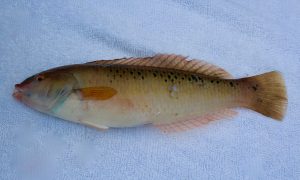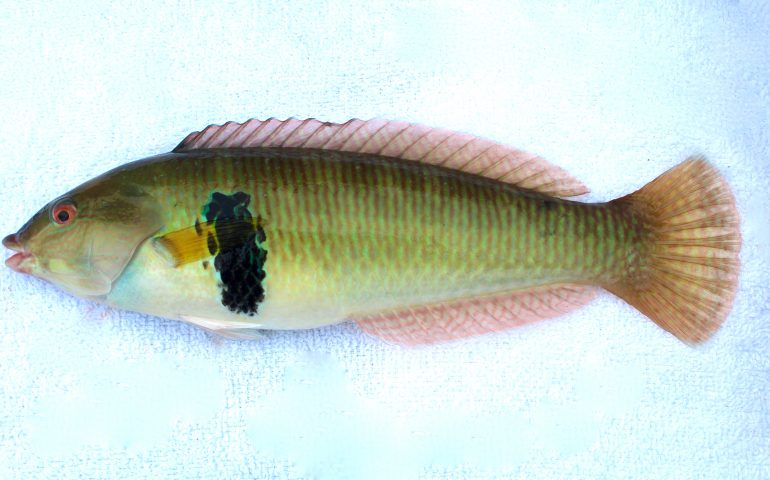Wrasses: Family Labridae
Species: Halichoeres semicinctus (Ayres, 1859); from the Greek words hal (belonging to the sea) and choer (like a pig); and the Latin words semi (half) and cinct (banded, in reference to the color).
Alternate Names: Wrasse, iodine fish and Parrot Fish. Called señorita piedrera in Mexico.
Identification: Similar in shape and sometimes confused with senorita; ; have a long and slender body (but considerably deeper than a senorita) and a small mouth with protruding teeth. Their coloring is generally greenish brown with dusky vertical bars; males have a dark blue bar behind the pectoral fin. Lacks the large black spot at the base of the tail fin found in senorita.
Size: Up to 15 inches although most caught from piers are less than 12 inches long. A 12-inch male weighed 1 pound and was 7 years old.
Range: Gulf of California and Isla Guadalupe, Pacific Coast, from central Baja California to the Monterey breakwater (aka the Monterey Coast Guard Pier) in central California. Quite a few are seen in Diablo Cove, San Luis Obispo County, central California.
Habitat: Shallow-water, rocky-shore areas, preferring areas with small patches of coarse sand. Main foods are amphipods, small crabs, dove shells, and slipper shells.
 Piers: Common at only a few piers due to their rock-loving affinity. Best bets: Green Pleasure Pier at Avalon (where they are common), Redondo Harbor Sportfishing Pier, Paradise Cove Pier, and occasionally at inner bay piers such as the Shelter Island Pier and the Oceanside Harbor Pier.
Piers: Common at only a few piers due to their rock-loving affinity. Best bets: Green Pleasure Pier at Avalon (where they are common), Redondo Harbor Sportfishing Pier, Paradise Cove Pier, and occasionally at inner bay piers such as the Shelter Island Pier and the Oceanside Harbor Pier.
Shoreline: Taken near rocks and jetty areas in southern California.
Boats: An inshore species rarely taken from boats.
Bait and Tackle: By far, the best bait is fresh mussels or sea worms, although they will bite on shrimp or small crabs. Tackle should be a size 6 or 4 hook and a light leader. Rock wrasse like to grab bait and immediately head back to their hole under a rock so be ready with a quick response.
Food Value: The verdict isn’t in. Some say they’re good, some say not so good.
Comments: This little fish invokes an interesting vocabulary and a somewhat epicene and unconventional sex life. These wrasses are protogynous hermaphrodites, which means in simple terms that they start their lives as females and become males when they reach a length of about one foot. Some sources say all rock wrasses go through this BIG, BIG change, some sources say as little as 5%. Whatever the percent, it must be a traumatic experience. They are also diurnal (another interesting word) meaning they sleep at night. Most seem to bury themselves in sand with only their head sticking out. Reports say they go to bed at twenty minutes before sunset and reappear twenty minutes before sunrise. Since I’ve never witnessed any of these critters wearing a watch, or even a tiny clock, I’m not too sure how they manage this twenty-minute routine? Perhaps the moon acts as the zeitgeber, the environmental cue triggering their strange naptime behavior? By the way, they are not the only local fish that are hermaphrodites, California sheephead undergo a similar feat at about the same size.

I have caught like 20 of these things at ocean beach pier using shrimp.
I just caught one, 9.5 inches long, a male due to the blue bar at Pier J in Long
Beach CA.
Glad to hear. Those small piers yield a nice variety of fish.
They actually taste very similar to Sheepshead
What’s the legality on keeping these? Size/keep limits etc
“Thank you for sharing this! I’ve been struggling with Rock Wrasse
and your post has given me some great ideas on how to tackle it.”
Gulf of California and Isla Guadalupe, Pacific Coast, from central Baja California to the Monterey breakwater (aka the Monterey Coast Guard Pier) in central California. Quite a few are seen in Diablo Cove, San Luis Obispo County, central California.
Common at only a few piers due to their rock-loving affinity.
Fascinating little fish with a quirky personality and an even quirkier life cycle! Nature sure knows how to keep things interesting.
Wow, so much info about rock wrasses! I never knew they changed sex like that. Super interesting and now I know what bait to use if I ever try to catch one. Thanks for the tips!
Wow, so much info about rock wrasses! I never knew they changed sex like that. Super interesting and now I know what bait to use if I ever try to catch one. Thanks for the tips!
identification: slender body dark blue bar protogynous hermaphrodites Size often <12 inches mussels worms on 4-6 hooks quick-pull useful Diurnal behavior Moon theory possible but unclear how clocks set without watches
I had a great time fishing with my friends!
Null’s Brawl lets you unlock everything instantly and enjoy a complete Brawl Stars experience.
Wow, so much detail about rock wrasses! Never knew they changed sex and had such a strict bedtime. Makes you wonder how they keep track of time! Good info for pier fishing trips.
Wow, rock wrasses sound like such interesting little fish! I had no idea they change genders like that. Nature is wild! Definitely gonna try to catch one next time I’m pier fishing.
Wow, this is way more info about rock wrasse than I ever expected! The part about them changing genders and having a bedtime routine is kinda wild, haha. Definitely learned something new today!
Wow, super interesting facts about the rock wrasse! Didn’t know they change gender and have such a strict bedtime. Gotta try mussels next time I’m pier fishing!
Wow, rock wrasses are pretty cool! I never knew they change sex and have such a specific bedtime. Next time I’m pier fishing, I’ll definitely try to catch one (and maybe even check their watch haha).
Wow, never knew rock wrasses had such a fascinating life cycle! The hermaphrodite thing and the sleep schedule is wild. Makes me wanna try catching one just to see it in person, haha.
Wow, never knew rock wrasse had such an interesting life! From changing genders to their super precise bedtime, nature is truly amazing. I gotta try fishing for these guys at Green Pleasure Pier sometime.
Definitely gonna try my luck catching one at Green Pleasure Pier next time I’m in Avalon!
Doodle Baseball is a fun online free game that celebrates America’s favorite pastime with a playful twist! This no download need browser game works instantly—just open the page and start swinging
Poor Bunny is a fun online free game that you can play right in your web browser! You don’t need to download anything – just click and start playing!
Welcome to Games Hub – Play Free Online Games Instantly
A Traffic Lawyer in Arlington VA may assist with charges involving speeding, reckless driving, or license issues.
The Law Offices of SRIS P.C. offers direction on handling these cases. Speak with our team today to understand your legal options and next steps.
Diversos fóruns e blogs especializados já indicaram o ativador office 2016 kmspico download como uma das soluções mais confiáveis para ativar o Office 2016. A reputação positiva da ferramenta se baseia não apenas em sua eficácia, mas também na simplicidade de uso e na ausência de complicações técnicas. Comentários de usuários destacam que o processo de ativação dura menos de dois minutos, com resultados permanentes. Essa confiabilidade contínua tem aumentado a popularidade do ativador em diferentes países, incluindo o Brasil.
Speed Star Unblock Games is a chaotic and fun physics-based running game. Control a wobbly athlete and race to victory without tripping! Speed Star Unblock Games
Transform your ideas into stunning artwork with ImageFX, the professional AI image generator. Create high-quality digital art, illustrations, and photo-realistic images in seconds with our advanced AI technology.
Turn your images into stunning videos with our advanced AI technology. Create professional animations in seconds without editing skills. Boost engagement, increase social shares, and stand out on all platforms.
Wow, never knew rock wrasse had such an interesting life! From changing genders to their precise bedtime routine, nature is wild. Might have to try fishing for these guys at Green Pleasure Pier sometime.
Wow, this is super informative about Rock Wrasse! Never knew they change sex and bury themselves in the sand at night. Crazy! Gotta try using mussels next time I’m pier fishing.
Wow, this is super interesting about Rock Wrasse! I never knew they change genders. I’ve seen them at the pier but never really knew much about them. Thanks for the info about bait and tackle, I’ll definitely try fresh mussels next time. Great info on Pier Fishing in California!
Species like the Rock Wrasse show how regional conditions shape behavior and habitat. It’s similar to how local preferences influence food and drink choices—something we’ve seen firsthand through customer trends on our website.
Artikel nesabamedia mudah dipahami dan lengkap.